Smut Clyde wants you to learn about Ekphrastic Studies. This sounds Greek but is actually a new Chinese and Iranian papermill business model at Hindawi, a once halfway OK-ish publisher (given the general standards of the field) which became a shameless scam operation once it has been acquired by Wiley in early 2021.
Wiley developed a rather fraud-positive attitude in the recent years, but this is nothing compared to the culture established at Hindawi now. There, anything goes. The artisan fraudsters and the “professional” papermillers don’t even pretend to make any sense with their fabrications, or that the western-sounding co-authors are real, some even openly admit that the data is made-up.
The scholarly publisher Hindawi was founded by Egyptian academic couple Ahmed Hindawi and Nagwa Abdel-Mottaleb in 1997 and converted to Open Access in 2007. Unlike Frontiers, it wasn’t known for inappropriate editorial practices, but then again, also Hindawi published a lot of silly trash. But then again, which publisher didn’t.
OA publishers Hindawi vs. Frontiers: similar, yet different
In this article, I will compare editorial policies of two for-profit open access (OA) publishers, Frontiers and Hindawi. Though both are members of OASPA and COPE as well as sponsors of DOAJ, respectively, Frontiers has been placed on the controversial Beall’s list of predatory publishers. Nevertheless, both OASPA and COPE expressed being “fully satisfied” with Frontiers. The two publishers…
The positive difference was Hindawi’s relatively decent stance on research integrity, fraudulent papers were often retracted despite authors’ protests. The publisher recruited Matt Hodgkinson, an experienced and dedicated professional as their head of the integrity team. But then Wiley bought Hindawi, and Hodgkinson somehow resigned. The new head of research integrity, the former Frontiers’ “Research Integrity Specialist” Ben Dickinson, doesn’t reply to emails, but this is standard policy at Wiley anyway. In a Wiley interview, Dickinson was quoted:
“Hindawi’s approach is very similar to Wiley’s approach as detailed above and we do not currently actively monitor commenting sites such as PubPeer, but we do investigate concerns initially raised on PubPeer when raised to us directly.”
Regarding citation scams, which is also the topic of Smut Clyde’s expose below, Dickinson said:
“At Hindawi, potential concerns can be raised to our attention using thresholds on the number or percentage of citations, however, the context of each citation will also be considered when determining whether concerning excessive citation exists.”
Truth is that all this is just smoke into your eyes. Hindawi became a wilful partner not just for citation cartels but also for Chinese and Persian papermills, publishing all kind of senseless trash in exchange for money. Even made-up authors with European names are not a red flag for this publisher’s expert team, probably actually a guarantee of quality, or of payment. What Hindawi does now would make OMICS blush. With envy.
Look, in the journal BioMed Research International Hindawi issued a Corrigendum for a paper “authored” by a bunch of PubPeer-notorious fraudsters, obviously because one of them failed to pay the papermill:
“In the article titled “Estimation of Isentropic Compressibility of Biodiesel Using ELM Strategy: Application in Biofuel Production Processes” [1], Adedoyin Isola Lawal was added to the author list in error. With the agreement of all authors,
Adedoyin Isola Lawal is now removed from the author list due to the lack of their contribution to the article.”
To call the new Hindawi a stinking overflowing latrine is an insult to all dirty toilets. So I shan’t do that, I will call Hindawi just this, until Ahmed Hindawi changes his name to avoid association.
Of course Smut Clyde made a spreadsheet, here it is. Of course Wiley and Hindawi will do nothing, but sure, I will send this article to Dickinson.
And now, over to Smut Clyde.

I’m pickin’ up good citations
By Smut Clyde
Nuclear physicists are used to sharing authorship with hundreds of people in sprawling collaborations, and some of the Higgs Boson announcements have author lists longer than the paper itself. Now Nick Wise reports a similar development in biomedicine: A paper where the second author is an entire French city.
Clermont Ferrand is in fact the Corresponding author, and can be contacted through an email address at King’s School – a private college in the Burundi capital city. The journal involved was Wireless Communications and Mobile Computing, part of the Hindawi stable, now a branch of Wiley.
“Construction of Agricultural Products of e-Commerce Ecological Network System under the Background of ‘Internet Plus’” (Zhong & Ferrand 2022).
Evidently King’s School encourages academic engagement and continued education, for Nick found its staff and students as authors of multiple Hindawi-journal productions – providing the Chinese co-authors signatories with the gravitas that comes from participation in international collaborations. But sadly, no-one could find any other evidence of existence for these festively-named individuals, who may well be Knock-Knock jokes that somehow gained sentience.

2022)



These all appeared in two Special Issues of Wireless Communications and Mobile Computing, titled “Explorations in Pattern Recognition and Computer Vision for Industry 4.0” and “Machine Learning Enabled Signal Processing Techniques for Large Scale 5G and 5G Networks“… edited by Kalidoss Rajakani and Mohammad Farukh Hashmi, so far containing 244 and 173 papers. But there are more examples, from other Special Issues of different journals.

It is all reminiscent of the implausible entities who emerged from quantum fluctuations in the space-time flux for just enough to sign “Maths Papermill” products before fading back into the quantum vacuum. Or the fictive dramatis personae who haunted J.BUOn before the bursting of that journal-shaped bubble. Or the fantasy characters who helped pad out ERMPS and the Special Issues of Journal of Intelligent & Fuzzy Systems with specious jibber-jabber, using burner email addresses provided to students at US community colleges: “Hailey Melvin“, “Henry Copland“, Li Kong / “Sandra Gruber“, Bo Zhao / “Brandon Martin“.
Begger’s test for Schrödingerean predator-prey system
Why is it that nobody remembers the name of [the famous mathematician] Johann Gambolputty…
Victims as perpetrators
Smut Clyde as Detective Columbo investigates: The victims of a paper mill are actually in cahoots with the perpetrators! Stealth corrections happen faster than one can catch them!


 Yes, yes, another papermill, catering to customers from China. This one is symbiotic with Hindawi, or even parabiotic. PubPeer contributors have been poking away at it for a while – notably Rhipidura albiventris – and I must credit them now before I forget. The features of the symbiosis are tiresomely familiar:
Yes, yes, another papermill, catering to customers from China. This one is symbiotic with Hindawi, or even parabiotic. PubPeer contributors have been poking away at it for a while – notably Rhipidura albiventris – and I must credit them now before I forget. The features of the symbiosis are tiresomely familiar:
- journals that publish only Special Issues (outsourcing editorial standards and discrimination to any random Guest Editor who suggests a topic);
- random References that serve only to inflate the bibliometric Citation Indices of those editors;
- pirated illustrations;
- burner email accounts, to allow the millers to pose as the corresponding authors.
The distinguishing feature here, that commends the symbiosis to our attention, is the explicit declarations that experiments are imaginary ones that authors would like to perform (using fantasy medical devices), so that the Tables and Figures are merely artistic impressions of what might emerge if the Tricorders were available and the experiments were realised. This is an unusual level of methodological honesty.
 From the publisher’s perspective, it is maybe peculiar but not their problem if a whole lot of wannabees throw money at them, eager to publish fantasised results of non-existent research. If this approach to science became more widely accepted, imagine the savings in research expenses! But it does seem that the journals should be renamed to reflect their emphasis on Ekphrastic Studies.
From the publisher’s perspective, it is maybe peculiar but not their problem if a whole lot of wannabees throw money at them, eager to publish fantasised results of non-existent research. If this approach to science became more widely accepted, imagine the savings in research expenses! But it does seem that the journals should be renamed to reflect their emphasis on Ekphrastic Studies.
 I hasten to remind the readers that ekphrasis is the rhetorical device where instead of advancing the action, an author lavishes description and praise on a painting or scene… generally an imagined work of art, which should exist in our consensus universe, but doesn’t. Like Bob Shaw’s descriptions of the other frames of da Vinci’s “Mona Lisa” animated movie. I contend that Lem’s ‘A Perfect Vacuum‘ and ‘Imaginary Magnitude‘, where he reviewed and introduced the books that he’d couldn’t be bothered to write, are ekphrases. Saunders and van Brakel argued in “Are there non-trivial constraints on colour categorization?” (1997) that the whole research program of cross-cultural color-naming is so riddled with circularity, hidden assumptions and explanatory gaps that reports of its discoveries are really an ekphrasis, but as a perceptual psychologist I could not possibly comment. Ignore the digression.
I hasten to remind the readers that ekphrasis is the rhetorical device where instead of advancing the action, an author lavishes description and praise on a painting or scene… generally an imagined work of art, which should exist in our consensus universe, but doesn’t. Like Bob Shaw’s descriptions of the other frames of da Vinci’s “Mona Lisa” animated movie. I contend that Lem’s ‘A Perfect Vacuum‘ and ‘Imaginary Magnitude‘, where he reviewed and introduced the books that he’d couldn’t be bothered to write, are ekphrases. Saunders and van Brakel argued in “Are there non-trivial constraints on colour categorization?” (1997) that the whole research program of cross-cultural color-naming is so riddled with circularity, hidden assumptions and explanatory gaps that reports of its discoveries are really an ekphrasis, but as a perceptual psychologist I could not possibly comment. Ignore the digression.
My favourite extrusion from this papermill is Qian (2022), from a Special Issue on “Laser Scanning Microscopy and its Biomedical Applications” in Scanning, for it has Figure 1, which someone thought was a good idea. The SI only contains 31 papers, and only eight papers have been examined so far and found to be bogus, but it is still open to submissions! Issue editor Balakrishnan Nagaraj has some explaining to do.¹
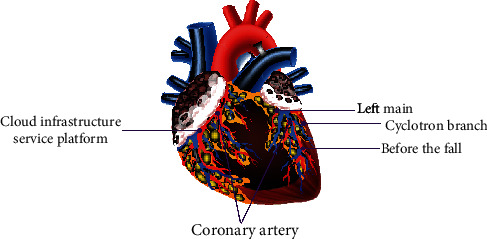
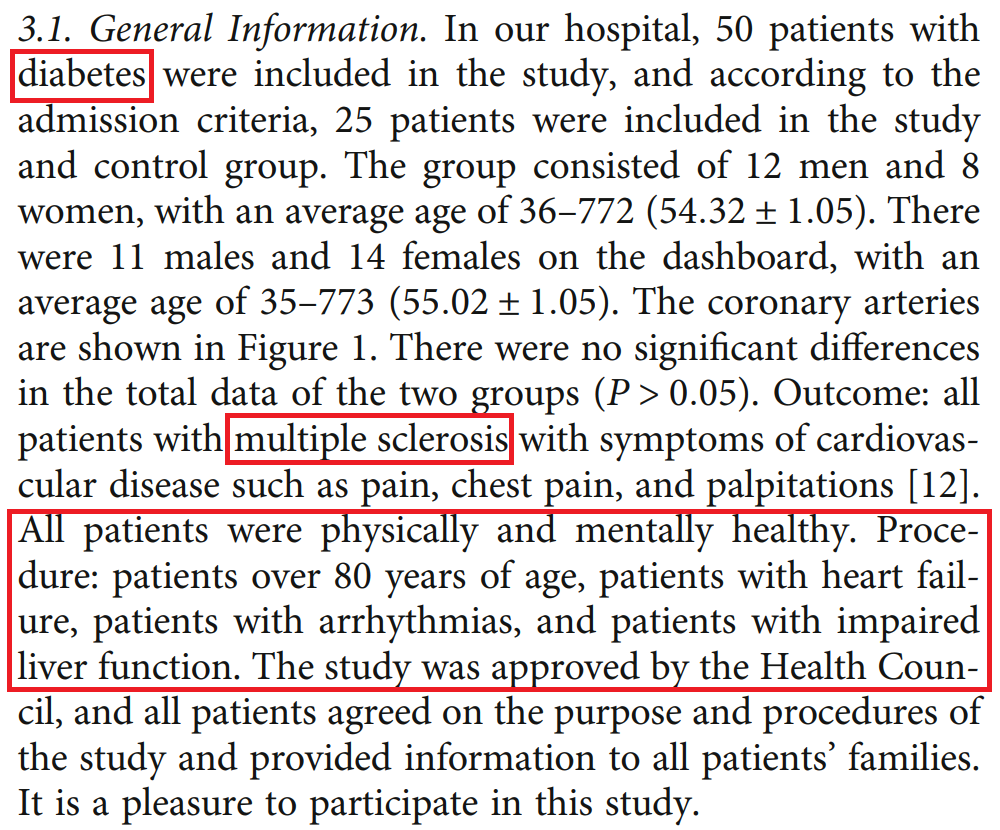 Tao Qian couldn’t decide whether to make up cases of heart disease or diabetes, multiple sclerosis, or liver failure. We do learn that everyone enjoyed the experience of contrast injection for CT scanning, which is reassuring… even the 25 patients “on the dashboard” (perhaps “control panel”).
Tao Qian couldn’t decide whether to make up cases of heart disease or diabetes, multiple sclerosis, or liver failure. We do learn that everyone enjoyed the experience of contrast injection for CT scanning, which is reassuring… even the 25 patients “on the dashboard” (perhaps “control panel”).
- “The study was approved by the Health Council, and all patients agreed on the purpose and procedures of the study and provided information to all patients’ families. It is a pleasure to participate in this study.”
- “There were 11 males and 14 females on the dashboard“
The papermillers who wrote the manuscript on Qian’s behalf submitted it through a disposable student email identity from Fujian Agriculture and Forestry University.

Another graduate of Fujian Agriculture and Forestry University was Shuliang Liu (of Yantaishan Hospital, Yantai), who co-authored a paper without knowing whether the topic was “solitary pulmonary nodules”, or aspergillosis, or AIDS.
- “From Figure 3, we can see that aspergillosis is extremely harmful in SPN, and its proportion of patients far exceeds other causes of SPN, accounting for more than 30% of the total number of patients. This shows that SPN is induced by aspergillosis. The possibility is much higher than other factors. In the case of preventing the occurrence of SPN, special attention should be paid to the impact of aspergillosis.”
- “Although other methods have their own advantages, in general, ddPCR can play an important role in the prevention of AIDS.”
Or possibly ischemic stroke.

We learn that “SPN refers to a single circular oedema with a diameter of thirty kilometres in the pulmonary spine”, which raises another possibility, that the authors mis-typed and their real topic was thermonuclear warheads. The conduit for this confused farrago was a SI on Augmented Reality and Virtual Reality-Based Medical Application Systems in Journal of Healthcare Engineering, edited by Zhihan Lv… 83 papers (so far), 15 of them flagged for bogosity (so far).
Anyway, back to Scanning, and back to “Laser Scanning Microscopy and its Biomedical Applications“. What happened here? An earthquake so strong that the seismograph broke? Someone trained a neural network on 200 examples of 45th-President’s signature?
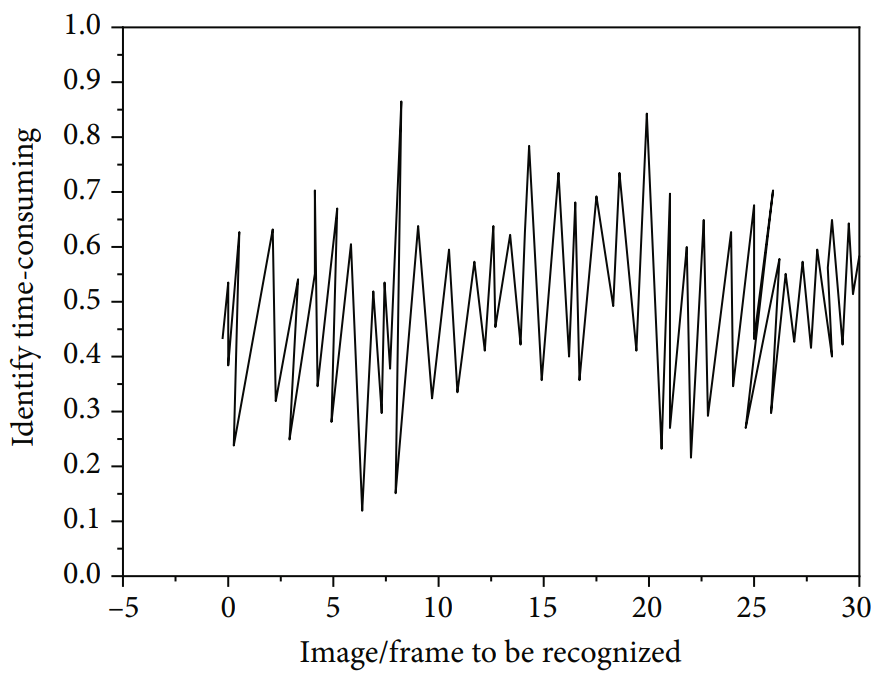
That is a trick question. It is “Time-consuming of damage identification method based on NMR”, Figure 2 of Zhou & Chu (2022): my second-favourite extrusion. The authors do not know the difference between NMR and MRI. The confusion is forgivable in faculty members of the Jiangxi Institute of Fashion Technology (Nanchang), but they are also unsure where they work, with an e-address obtained from Nanjing Agricultural University.
“Correspondence should be addressed to Wenyong Zhou; 31115317@njau.edu.cn”
Nick Wise advises that the work of papermillers is made easier – especially the part where they acquire a burner email identity for submitting each manuscript and negotiating with the editors on behalf of the nominal authors – by a marketplace for student accounts. Websites trade in institutional affiliations for various colleges in China, and Vietnam, and even in Burundi. Case in point, the sibling accounts ‘edulonely009@stu.t.edu.vn’ and ‘edulonely010@stu.t.edu.vn’, used to submit two papers to that J. Healthcare Engineering “Augmented Reality” SI.
- “Application of 64-Slice Spiral CT Imaging Technology Based on Smart Medical Augmented Reality in the Diagnosis of Foreign Bodies in the Respiratory Tract in Children” (Liu et al 2021)
- “Analysis of PICC Based on Dysfunction Module Personalized Nursing Treatment in Chemotherapy of Advanced Esophageal Cancer” (Zhang et al 2021)
The coincidence was no concern to Zhihan Lv. I don’t know what happened to the rest of the edulonely family and I hope they’re OK.
“North University of Nationalities” is one prolific supplier of email accounts, to the extent that many email services block any messages from a XXXX@stu.nun.edu.cn address as probable spam, but Hindawi do not use that block list. This is fortunate for our papermillers who had invested in several sequential blocks of accounts of that form. Two featured in that “Augmented Reality” special issue:
- 20111290@stu.nun.edu.cn: “Clinical Acupoint Selection for the Treatment of Functional Constipation by Massage and Acupuncture Based on Smart Medical Big Data Analysis” (Sun et al 2021)
- 20111291@stu.nun.edu.cn: “Clinical Study of Virtual Reality Augmented Technology Combined with Contrast-Enhanced Ultrasound in the Assessment of Thyroid Cancer” (Liu et al 2021)
We will come back to Liu et al (2021), because of its discoverer’s explanation (PubPeer contributor Schizomeris leibleinii):
“I found this paper shaped object by looking for papers that cite Mohamed Elhoseny, which seems to be a good indicator of unsuitable citations (there are >3500 papers out there citing M. Elhoseny, so I’ll have to do a lot of work).”
Four appeared in Journal of Healthcare Engineering, in a SI on “Deep Unsupervised Learning for Healthcare Data Analytics” edited by our serial editor Balakrishnan Nagaraj. It contains 61 papers (so far); four flagged (so far).
- 20122472@stu.nun.edu.cn: “A Virtual Reality Algorithm for the Study of Clinical Efficacy of Sports Injury Rehabilitation Training” (Han 2021)
- 20122474@stu.nun.edu.cn: “Design of the Exercise Load Data Monitoring System for Exercise Training Based on the Neural Network” (Qin & Feng 2021)
- 20122475@stu.nun.edu.cn: “The Design of a Track Monitoring System for Sports Injury Rehabilitation Training” (Li et al 2021)
- 20122476@stu.nun.edu.cn: “The Application Value of MRI in the Training and Physical Rehabilitation of Gastrocnemius with Acute Sports Injury” (Zhang & Liu 2021)
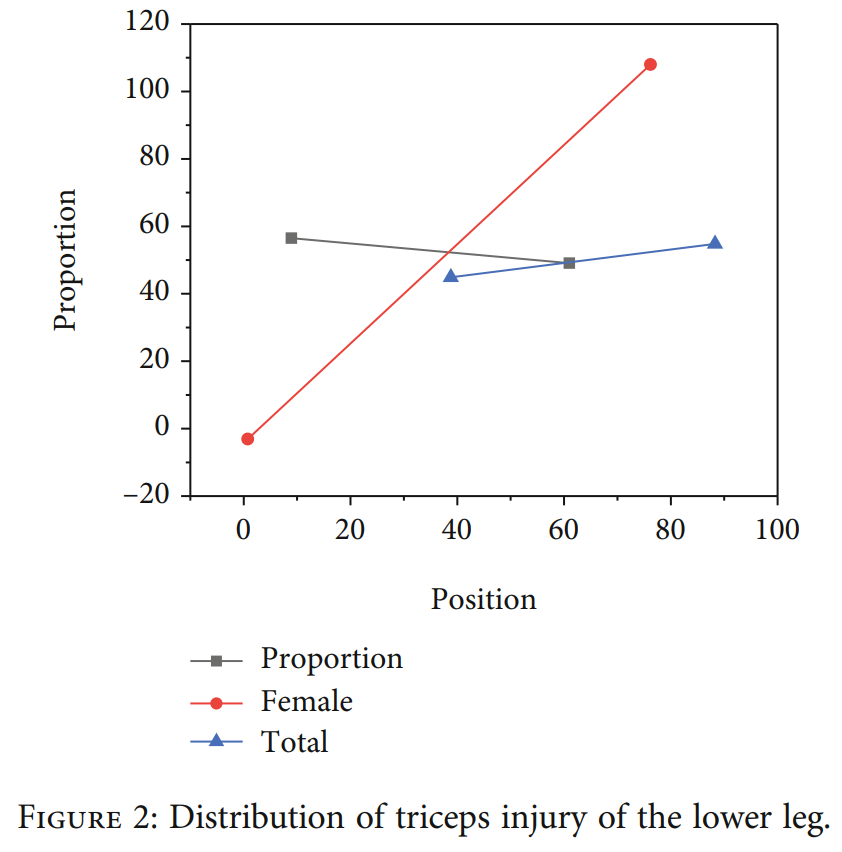
Student accounts of the form XXX@mails.imnu.edu.cn, bought en masse from Inner Mongolia Normal University, are also popular, and sequential.
- 20162103812@mails.imnu.edu.cn: “The Diagnostic Value of Scanning in the Injury of Triceps Crus of Volleyball Players” (Zhao & Liu 2022)
- 20162103813@mails.imnu.edu.cn: “Application of Data Mining Technology in Software Intrusion Detection and Information Processing” (Zhao 2022)
Nor should we forget Hainan College of Economics and Business, whose students are dispersed all across China. ‘202007000161@hceb.edu.cn’ (alias Wanning Zhu) signed a glorious confection about measuring human fatigue and memory through tasks like weight-bearing swimming. platform-jumping, pole-climbing, Morris water maze… these are all rodent-specific tests, but someone yoinked paragraphs of text from elsewhere and changed “mouse” to “human” throughout.

“The climbing pole model device is simple, but some often jump down because they are unwilling to climb the pole, and uncontrollable factors such as the smoothness and scratch degree of the climbing pole will also affect the experimental results.”
“Honest, I was only in that club watching the young ladies with the poles in order to measure their climbing time and calculate their level of fatigue.“
Anyway, these institutions have their own faculty, trying to publish legitimate research. So the e-addresses are not always monetarised and a hallmark of shenanigans. These burner e-addresses are also used for fake papers in other publishers – not necessarily by the same papermill.
So it’s time to look closer at the Special Issues. Hindawi was known for its lean business model, and a low staffing ratio of full-time editors. The low-staff model leads naturally to what one might call the MDPI approach to fishing, i.e. casting out multiple Special-Issue-shaped nets with an associate Editor or Guest Editors in charge of each one. The lack of in-house expertise low overheads made Hindawi an inviting acquisition, explaining why John Wiley &c paid $298 million for it – seven times its income stream (which might otherwise have seem an over-valuation)². It also weakened the journals’ resistance to fabrication, and made them an inviting target for papermills.
Now when there are mumblety-mumble journals in the stable (or mews as the case may be)³, while each extrudes hundreds of SIs per year with dozens of papers in each – or dozens of SIs each year with hundreds of papers in each – then the self-appointed blackboard monitors at PubPeer are unlikely to bother to sample them in a systematic, representative way. Just as barrels already known to contain fish attract more marksmanship, so scrutiny is focussed on journals where junk papers were already found. So it’s hard to generalise from those papers that have been flagged at PubPeer and listed in a spreadsheet here. It does seem, though, that J. Healthcare Engineering is notably papermill-friendly. Conceivably some of the papers in its SIs aren’t papermill products but fell in with bad company. Computational Intelligence and Neuroscience, Scanning and Wireless Communications and Mobile Computing are close contenders, though.
The SI titles are assembled from parascience Worship Words: Blockchain! Virtual Reality! Fuzzy Logic! Big Data! Neural Network! Deep Learning! Internet of Things!
- Advanced Computational Intelligence for Smart Healthcare and Human Health Using Few-Shot Learning
- Compression of Deep Learning Models for Resource-Constrained Devices
- Cross-Media Data Analytics for Intelligent Computing Based on Deep Neural Networks
- Ubiquitous Artificial Intelligence Enabled Next Generation Wireless Systems
- Advanced Artificial Intelligence and Machine Learning in Healthcare 5.0
- AI-Enabled Internet of Things in Sport and Public Health
- Augmented Reality and Virtual Reality-Based Medical Application Systems
 As long as the right Worship Words are echoed in each Title and Abstract, the editors are relieved of the need to read any further. Thus the confections stove-piped through each cloaca maxima are chimeras: one half, consisting of specious results from an imagined experiment, is unrelated to the other half – which is a garbled exegesis of mathematical fiddle-faddle, to bring the conjoined halves under the aegis of that ill-defined topic.
As long as the right Worship Words are echoed in each Title and Abstract, the editors are relieved of the need to read any further. Thus the confections stove-piped through each cloaca maxima are chimeras: one half, consisting of specious results from an imagined experiment, is unrelated to the other half – which is a garbled exegesis of mathematical fiddle-faddle, to bring the conjoined halves under the aegis of that ill-defined topic.
But where there are SIs, citation plantations and absurdist Reference Lists are never far away (Arnold & Fowler, 2010). The specific ignis fatuus that led me to this genre was an eclectic handful of papers that seemed to be in high-rotate, arousing curiosity about who else might be citing “Cephalopod-inspired miniaturized suction cups for smart medical skin”, “Utilization of smart phones related medical applications among medical students at King Abdulaziz University, Jeddah“, and a few others. “Everyone”, was the answer. A cluster of papers by Zhihan Lv were also curiosity-arousing, on account of attracting more citations than one might expect from their niche topics… especially from papermill products that were vying for inclusion in that SI on “Augmented Reality and Virtual Reality-Based Medical Application Systems” (edited by Zhihan Lv).
- “The Security of Medical Data on Internet Based on Differential Privacy Technology” (Lv & Piccialli, 2021)
- “The influence of immersive virtual reality systems on online social application” (Yan & Lv, 2020)
- “Virtual reality in the context of Internet of Things” (Lv 2020)
- “Deep learning enabled security issues in the internet of things” (Lv et al 2020)
- “6G-enabled network in box for internet of connected vehicles” (Lv et al 2020)
- “AI-enabled IoT-edge data analytics for connected living” (Lv et al, 2021)
Which is not to say that an editorial role is essential for benefiting from citational generosity, for there is a collegial kind of professional courtesy and mutual back-scratching within this ecosystem of academic exploitation. As noted, Schizomeris leibleinii stumbled upon this publisher while following the spoor of M. Elhoseny.
The Men Who Stare at Ketotic Cows
“The References dwell on bovine indigestion, seizures, and the work of N. Arunkumar.” – Smut Clyde, jazz-punk Klezmer musician.
Wiley: Committed to integrity? Get out!
“We have initiated post-acceptance peer review with independent reviewers… ” – Wiley.
Now Elhoseny is a poster-boy for the academic career-path of citation-coercing shamelessness, fêted by publishers and colleagues alike, always available to guest-edit a potboiler volume or a Special Issue of production-line wordwoose in return for boatloads of citation donations from the contributors. Of course he is not alone. If Hindawi‘s new owners need suggestions for additional Guest Editors, Alexander Magazinov is determined to map out the whole network.

At best, the Reference Sections in this genre should be headed with a disclaimer to the effect that any resemblance to the in-text citations is purely coincidental. The tasks of (a) assembling the text and inserting citation call-outs [1], [2], [3]… at regular intervals, and (b) scrapbooking Google-suggested papers into a Reference list are evidently handled at separate desks in the mill, with little communication between departments. The template calls for a ‘Related Works’ / Literature review section that misrepresents the contents of three or four of these accidental references, their lack of relevance justifying a declaration that the present authors’ research question has not yet been adequately addressed in the literature.
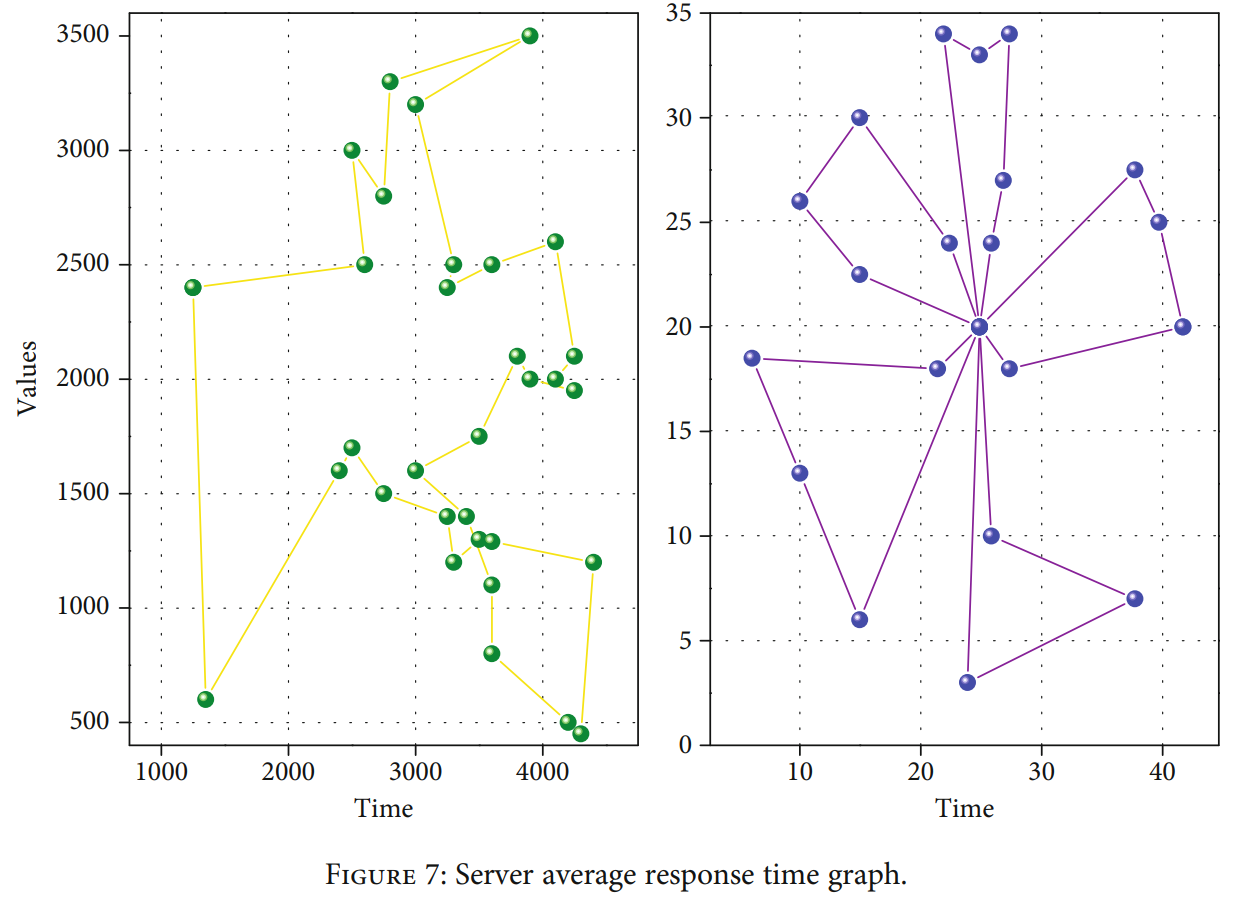
Real scientific papers have Figures, conveying experimental results in pictorial language for the sake of clarity and brevity, so of course these cargo-cult imitations do have pictures that fill the gaps between paragraphs and seem to illustrate something as long as you don’t look at them too closely. Excel and Powerpoint offer many options for turning the output of a random-number generator into chartjunk; or the figures might be scraped from social media or churnalism sites, whichever takes least effort (it is not as if the millers need to work around the doubts or incredulity of the editors). The results could charitably be described as ‘specious drivel’.
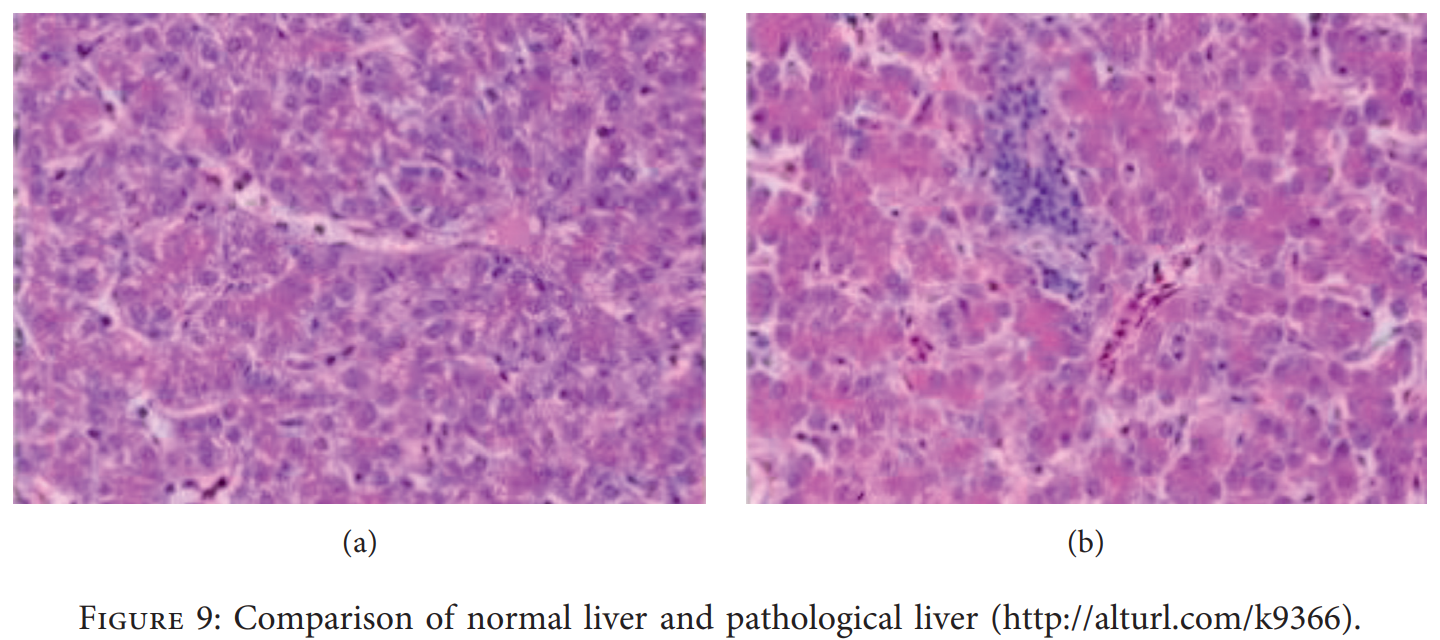
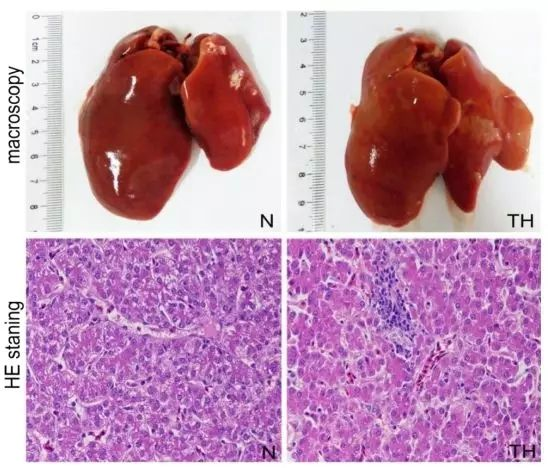 So Yan & Zhang (2021) repurposed normal and chromium-poisoned slices of chicken liver to illustrate their report that silybin reduces hepatic injury in humans. Readers are warned that “Data sharing not applicable to this article as no datasets were generated or analyzed during the current study”. Corresponding author Zhang is another student at Fujian Agriculture and Forestry University, or at least has an email account there. The Citations include
So Yan & Zhang (2021) repurposed normal and chromium-poisoned slices of chicken liver to illustrate their report that silybin reduces hepatic injury in humans. Readers are warned that “Data sharing not applicable to this article as no datasets were generated or analyzed during the current study”. Corresponding author Zhang is another student at Fujian Agriculture and Forestry University, or at least has an email account there. The Citations include
- M. Abdel-Basset, M. Elhoseny, A. Gamal, and F. Smarandache, “A novel model for evaluation hospital medical care systems based on plithogenic sets, artificial intelligence in medicine,” Artificial Intelligence in Medicine, vol. 100, Article ID 101710, 2019, In press.
No-one was surprised when “8-FDG PET scans show[ing] hypermetabolism in the striatum and brainstem” (of a 49-year-old man with IgLON5-mediated neurodegeneration) was repurposed as Figure 3, “ChR2 protein-specific expression in cholinergic interneurons of [rat] striatum” – not the only pictorial imposture in Ji & Li (2021). Readers may enjoy the self-exculpatory response from Xin Li, if they can extract some sense from the sepia cloud of evasions. Unusually, the paper was not assigned to a Special Issue of J. Healthcare Engineering, so I guess the journal publishes regular issues as well.
I have no idea what “tidal dressing” is, or how rats are euthanised by shaving them, and Li’s explanation did not enlighten us.
- “The stimuli we use include the following types: 24 hours without water, 24 hours without meals, 12-hour day and night replacement, 24 hours without tidal dressing fee, 24 hours tilt cage, pinch the tail for 1 minute, and vibrate for 5 minutes.”
- “10 rats in the NS group and the model group were collected by anesthesia and hair removal, respectively. The brain was removed, and the brain tissues of the linear bodies and hippocampus were separated.”

 I am not detecting a great deal of pride in workmanship. Another example? Fig 1 of Xie et al (2021), “Chronic obstructive lung characteristics”, turns out to be sourced from “Case 28-2019: A 22-Year-Old Woman with Dyspnea and Chest Pain“… though filtered through a series of Chinese websites. While on close inspection of Fig 6, “The current quality of life of COPD patients at different stages of pulmonary rehabilitation exercise behavior”, the panels turn out to be not directly lung-related, but MRI-scan slices of a massive cerebral hemorrhage. Happily, the 73-year-old patient was saved by prompt craniectomy and decompression. The putative authors do warn us that “No data were used to support this study”.
I am not detecting a great deal of pride in workmanship. Another example? Fig 1 of Xie et al (2021), “Chronic obstructive lung characteristics”, turns out to be sourced from “Case 28-2019: A 22-Year-Old Woman with Dyspnea and Chest Pain“… though filtered through a series of Chinese websites. While on close inspection of Fig 6, “The current quality of life of COPD patients at different stages of pulmonary rehabilitation exercise behavior”, the panels turn out to be not directly lung-related, but MRI-scan slices of a massive cerebral hemorrhage. Happily, the 73-year-old patient was saved by prompt craniectomy and decompression. The putative authors do warn us that “No data were used to support this study”.
I shouldn’t over-emphasise these explicit assertions that a paper is merely an aspirational artistic rendering of a fantasised experiment, and that the results are ekphrastic:
Data sharing is not applicable to this article as no datasets were generated or analysed during the current study.
They are a minority, and most of the entries in the spreadsheet are less honest. They pretend that
The data used to support the findings of the study can be obtained from the corresponding author upon request.
Or even
The data used to support the findings of this study are included within the article.
In practice the corresponding authors are unreachable, due to those single-use student email accounts that no-one at the papermill monitors once the manuscript is in press. From 145 papers flagged at PubPeer (so far), precisely one author has replied.
For all I know, Hindawi publishes review papers and opinion pieces, so a ‘No Data’ declaration is not problematic per se (in fact the declaration is one option suggested by the template for readying one’s manuscript for submission). So the problem might not be as bad as it first seems… merely HUGE rather than COLOSSAL.
 All of this so far is just the thin end of the white elephant and the tip of the slippery slope. The pace of the production line for the last two years is phenomenal (no bogosity has shown up from before 2021, though it may be that fuckery was afoot and editors were wetting their beaks even before the Wiley acquisition). Just one Google Scholar search, focusing on the applications of multimedia / IoT / Fuzzy Logic / Big Data / Blockchain for political indoctrination, picks up 138 implausible titles. Perhaps this intersection of topics attracts enthusiasm and funding from the authors’ institutions.
All of this so far is just the thin end of the white elephant and the tip of the slippery slope. The pace of the production line for the last two years is phenomenal (no bogosity has shown up from before 2021, though it may be that fuckery was afoot and editors were wetting their beaks even before the Wiley acquisition). Just one Google Scholar search, focusing on the applications of multimedia / IoT / Fuzzy Logic / Big Data / Blockchain for political indoctrination, picks up 138 implausible titles. Perhaps this intersection of topics attracts enthusiasm and funding from the authors’ institutions.
More products of the millers are revealed by their habit of drawing nonsensical citations from a kind of lucky-dip to pad out the Reference sections of their work. These are selective, diagnostic citations; found scores of times in wildly-unrelated Hindawi journals, or 100s of times, while escaping the notice of the rest of the academic literature. The millers aren’t trying very hard to disguise their efforts. It is just coincidence that several of these high-rotation citations are by serial editors like Balakrishnan Nagaraj and Danilo Pelusi.
- “Conceptual Implementation of Artificial Intelligent based E-Mobility Controller in smart city Environment” (Jayakumar, Nagaraj et al, 2021) – 104 citations.
- “Experimental, computational analysis of Butein and Lanceoletin for natural dye-sensitized solar cells and stabilizing efficiency by IoT” (Bradha, Nagaraj et al, 2021) – 73 citations.
- “Intelligent Network Intrusion Prevention Feature Collection and Classification Algorithms” (Selva, Nagaraj, Pelusi et al, 2021) – 58 citations.
- “Deep Learning-Based Real-Time AI Virtual Mouse System Using Computer Vision to Avoid COVID-19 Spread” (Shriram, Nagaraj et al, 2021) – 57 citations.
One final caveat: I have written as if only one papermill is entwined with Hindawi in a symbiotic, mutually-beneficial embrace. There could easily be a whole roster of content producers working through a single broker,4 each with a slightly different signature. Taxonomising them is not my problem.
CODA
This small but lovingly-curated collection of seemingly-unrelated papers is not directly linked to Hindawi. I append it anyway because what they have in common is a payload of 46 Elhoseny papers dominating their References sections – a veritable academic CV. A series of vapid, content-free sentences provide the camouflage for this career-enhancing malarkey, interspersing the Elhoseny fan-service with equally nonsensical citations about aspects of architecture and construction in Iran. Nine unrelated teams of authors were independently seized by an eleemosynary impulse to boost Elhoseny’s scholarly statistics on an industrial scale; and what diverse collaborations they are!
- “A coupled Galerkin and Newmark techniques for resonance simulation of the electrically single-curved system under low-velocity impact” (Zhang et al 2021).
- “A particle swarm optimization and coupled generalized differential quadrature element methods with genetic algorithm for stability analysis of the laminated microsystems” (Sun 2021).
- “Acoustic Detection and Recognition of Dolphins using Swarm Intelligence Neural Networks” (Wu et al 2021).
- “Bending analysis of the multi-phase nanocomposite reinforced circular plate via 3D-elasticity theory” (Shao et al 2021).
- “Computer modeling for frequency performance of viscoelastic magneto-electro-elastic annular micro/nanosystem via adaptive tuned deep learning neural network optimization” (Guo et al 2021).
- “Computer simulation for stability performance of sandwich annular system via adaptive tuned deep learning neural network optimization” (Ming et al 2021)
- “Diagnosis from CT scan images in complex biological media using deep learning and wave application: a Hunger Games search-based approach” (Wang et al 2021).
- “Pulmonary Diffuse Airspace Opacities Diagnosis from Chest X-Ray Images Using Deep Convolutional Neural Networks Fine-Tuned by Whale Optimizer” (Wang et al 2022).
- “Separation of tumor cells from the peripheral blood via a novel electro hydrodynamics model” (Li et al 2021).
Often the first author (or pair of authors) comes from China; the others might be Iranian, intermingling with names from Russia etc. Which is to say, authorship has been sold, probably on behalf of the Iranian authors, who may be profiting from the sale of citations as well. M. Elhoseny may be directly involved in the trade, or maybe not. I have so many questions!
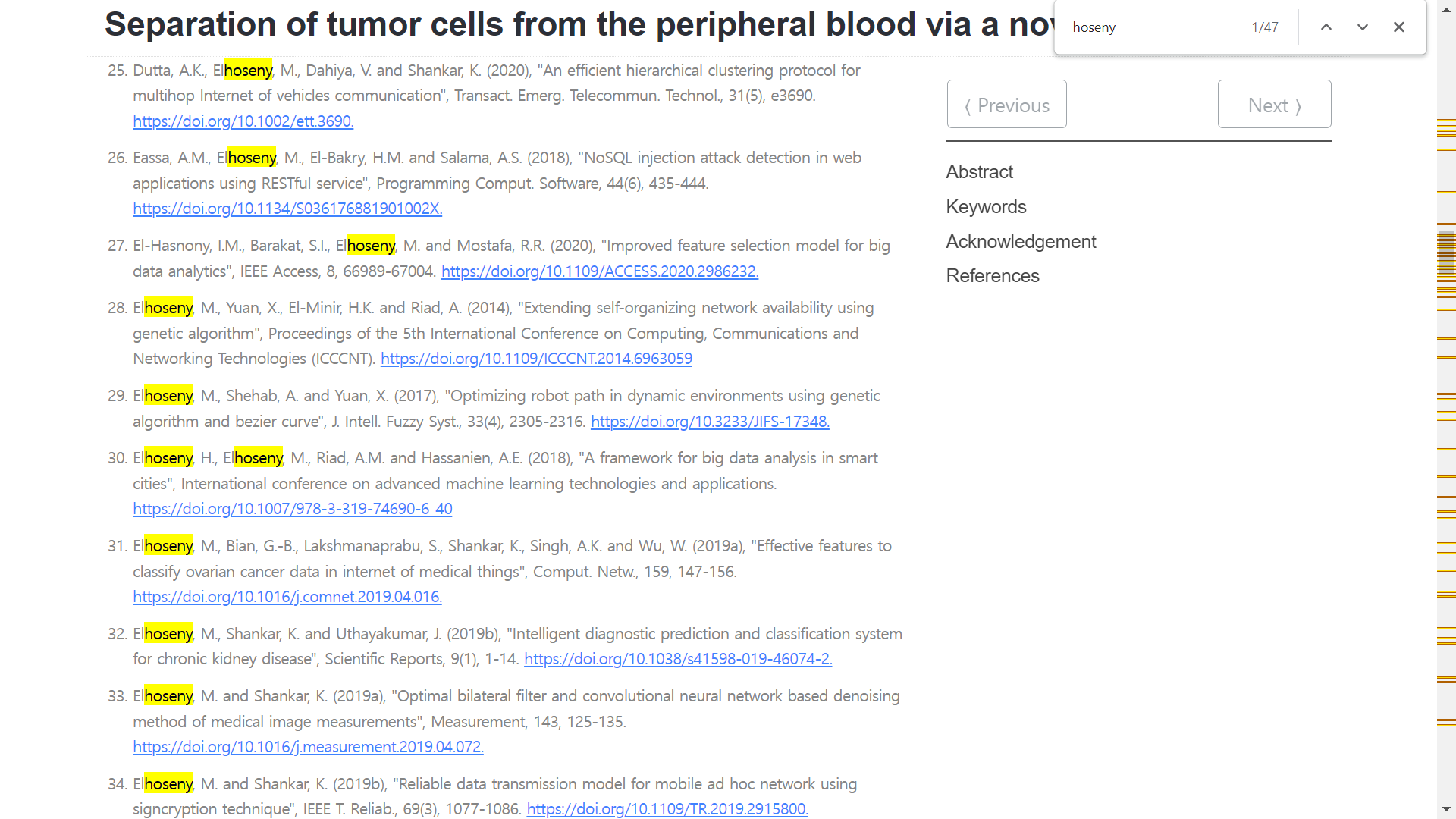
* * * * * * * * * * * * * * * *
1. “Balakrishnan Nagaraj is working as a Professor and Head in the Electronics and Communication Engineering Department at Karpagam College of Engineering, India. He worked as an academician for 12 years in various positions. His technical expertise and research interests include a control system, automation, soft computing, and high-speed signal processing. He is a member of various professional bodies like IEEE, MAENG, IACSIT, ISTE and IETE. He is a reviewer for different reputed journals like Elsevier, Wiley, Inderscience etc., and he has been the Guest Editor for few special issues in Hindawi, Elsevier, Inderscience, Springer, etc.“
Those “different reputed journals” come from dubious publishers like AIMS and Tech Science and Bentham – though Bentham thought better of the link and deleted it a few days ago.
2. There are also “synergies” to justify the price-tag, and “beneficial impact on article cascade“, where each rejection of a paper from a subscription-model Wiley journal is combined with a suggestion that the authors pay to have it published in a Hindawi journal instead.
I don’t know what “upsell opportunities for publishing and platform services” are but I hate them already.
3. “Stables” are rural and house working horses. A “mews” is urban and is where rich people keep horses for displaying wealth. English is a weird language.
4. An ‘agent’, in Adam Day’s perspective on the paper-forging ecosystem.


Donate to Smut Clyde!
If you liked Smut Clyde’s work, you can leave here a small tip of 10 NZD (USD 7). Or several of small tips, just increase the amount as you like (2x=NZD 20; 5x=NZD 50). Your donation will go straight to Smut Clyde’s beer fund.
NZ$10.00







LikeLike
LikeLike
People have too much spare time, with the result that the “Hindawi papermill” spreadsheet now contains 1118 papers (with no end in sight). https://docs.google.com/spreadsheets/d/1YL5rMrZoUcp3rn1mP7B_X9QE08VPGXehhK-dlkFN_Iw/edit?usp=sharing
Wiley do not seem all that concerned that their new subsidiary has turned into a stovepipe for bogus papers. I guess the cheques clear whether or not the peer-reviewing is genuine.
That’s not counting the six papers from one issue of “Nonlinear Engineering” (a De Gruyter journal), or the nine papers in various Frontiers journals (six of them in a Special Topic on “Advanced Application of Deep Learning, Statistical Modelling, and Numerical Simulation on Geo-Environmental Hazards”). The papermill is looking for new targets!
LikeLike
Pingback: Papermill – your local partner for Special Issues in China – For Better Science
Pingback: Hindawi Garbage Sorting System, Based on Citations – For Better Science
“The conduit for this confused farrago was a SI on Augmented Reality and Virtual Reality-Based Medical Application Systems in Journal of Healthcare Engineering, edited by Zhihan Lv… 83 papers (so far), 15 of them flagged for bogosity (so far).”
Which was quite instrumental to Zhihan Lv in securing a job at… Uppsala university!
https://www.katalog.uu.se/profile/?id=N21-2049
LikeLike